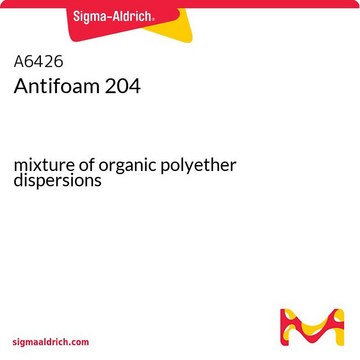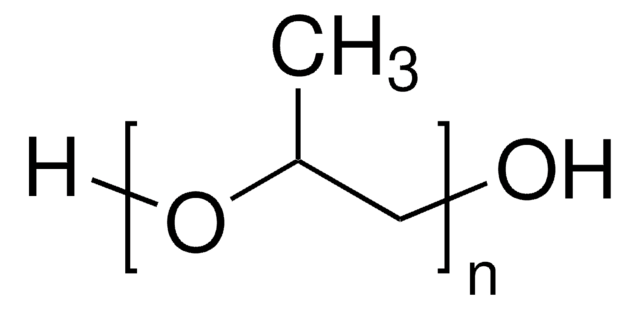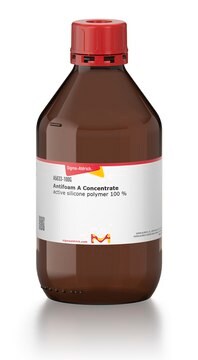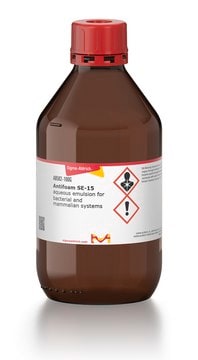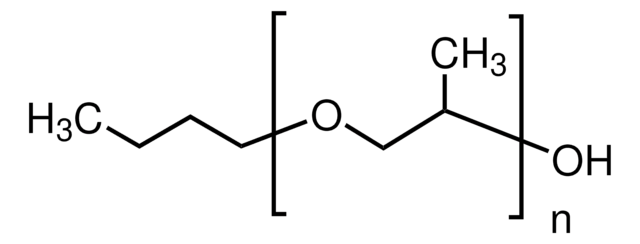81380
Polypropylene glycol
P 2,000
Sinónimos:
PPG
Iniciar sesiónpara Ver la Fijación de precios por contrato y de la organización
About This Item
Número de CAS:
MDL number:
UNSPSC Code:
12162002
PubChem Substance ID:
NACRES:
NA.23
Productos recomendados
Quality Level
form
liquid
mol wt
Mn 1513
refractive index
n20/D 1.451
viscosity
~450 mPa.s(20 °C)
solubility
water: miscible (completely)
density
1.00 g/mL at 20 °C
InChI
1S/C6H14O3/c1-5(8)4-9-6(2)3-7/h5-8H,3-4H2,1-2H3
InChI key
DUFKCOQISQKSAV-UHFFFAOYSA-N
¿Está buscando productos similares? Visita Guía de comparación de productos
General description
Polypropylene glycol is an addition polymer of propylene glycol and water. It is represented by the formula HO(C3H6O)nC3H6OH in which n represents the average number of oxypropylene groups. Polypropylene glycol is soluble in water and in certain organic solvents as aliphatic ketones and alcohols and insoluble in ether and in most aliphatic hydrocarbons.
Application
Polypropylene glycol (PPG)is widely used as an antifoaming agent. For example, it can be used to controlfoam in the production of Bacillus thuringiensis-based biopesticides fromsewage sludge.
It can be used in thepreparation of polyurethane(PU) elastomers. For example, it can be used tosynthesize PU elastomers with good acoustic absorption properties.
PPG-2000 can be used as a soft segment in the preparationof PU-based self-healing polymeric networks. These networks find application in the field of soft electronics.
It can be used in thepreparation of polyurethane(PU) elastomers. For example, it can be used tosynthesize PU elastomers with good acoustic absorption properties.
PPG-2000 can be used as a soft segment in the preparationof PU-based self-healing polymeric networks. These networks find application in the field of soft electronics.
Features and Benefits
- Long and flexible alkyl groups promotechain mobility, which facilitates rapid self-healing.
- The methyl groups present on the sides of thepolymer improve emulsification in water.
Storage Class
10 - Combustible liquids
wgk_germany
WGK 1
flash_point_f
445.0 °F - closed cup
flash_point_c
229.44 °C - closed cup
ppe
Eyeshields, Gloves
Elija entre una de las versiones más recientes:
¿Ya tiene este producto?
Encuentre la documentación para los productos que ha comprado recientemente en la Biblioteca de documentos.
Los clientes también vieron
Mohammed Taghi Zafarani-Moattar et al.
Biotechnology progress, 28(1), 146-156 (2011-09-29)
In this work, we proposed a novel aqueous biphasic system (ABS) composed of polypropylene glycol P400 (PPG P400) and hydrophilic ionic liquids (IL), 1-alkyl-3-methylimidazolium bromide (alkyl = ethyl or butyl), forming an upper polymer-rich phase and a lower IL-rich phase
Celeste R Brennecka et al.
World neurosurgery, 78(5), 469-480 (2011-11-29)
Current treatments for cerebral aneurysms are far from ideal. Platinum coils are prone to compaction, and currently used liquid embolics are delivered with angiotoxic agents. This work presents initial in vivo studies of a novel liquid-to-solid gelling polymer system (PPODA-QT)
John Texter et al.
Macromolecular rapid communications, 33(1), 69-74 (2011-12-03)
The controlled atom transfer radical polymerization of an ionic liquid, 1-(11-acryloylundecyl)-3-methyl imidazolium bromide (ILBr), from both ends of a telechelic poly(propylene oxide) (PPO) macroinitiator, end-functionalized with bromoisobutyryloyl is reported. The resulting highly water-soluble triblock, poly(ILBr-b-PO-b-ILBr) is multistimuli responsive. This new
Flávia Chiva Carvalho et al.
Journal of biomedical nanotechnology, 8(2), 280-289 (2012-04-21)
In the last few decades, nanotechnology has led to an advance in the development of topical drug delivery. Nanostructured drug delivery systems enable the compartmentalization of drugs in restricted environments, modifying the release profile and maintaining the required drug concentration
R De Lisi et al.
Physical chemistry chemical physics : PCCP, 13(27), 12571-12577 (2011-06-15)
The study highlighted the main forces driving the formation of hydroxypropyl-cyclodextrins (HP-CDs) + poly(propylene) glycol 725 g mol(-1) inclusion complexes. The temperature parameter was chosen as the variable to modulate the hydrophobicity of the polymer, and consequently ITC experiments as
Nuestro equipo de científicos tiene experiencia en todas las áreas de investigación: Ciencias de la vida, Ciencia de los materiales, Síntesis química, Cromatografía, Analítica y muchas otras.
Póngase en contacto con el Servicio técnico